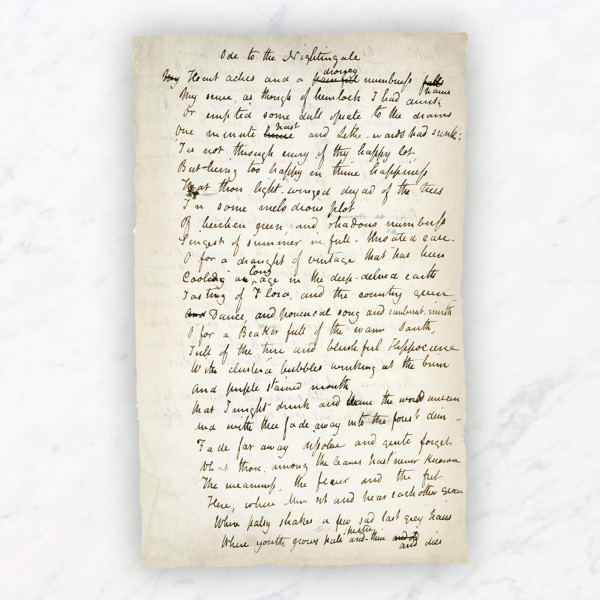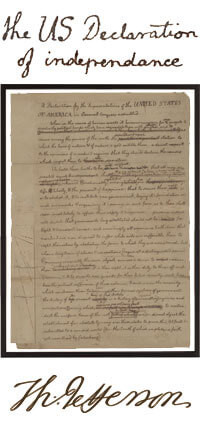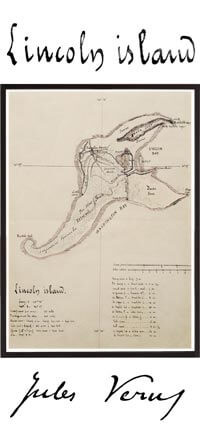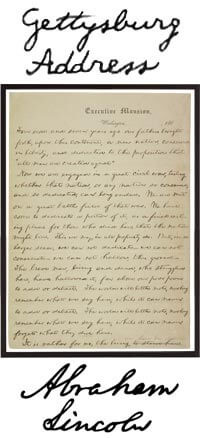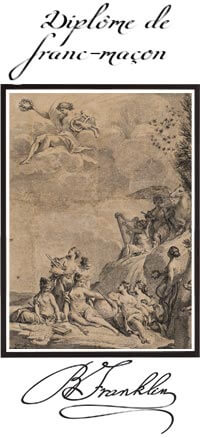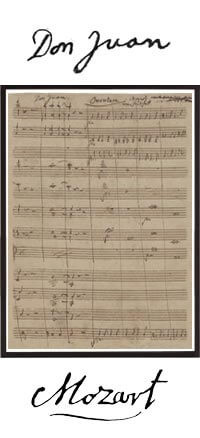Ode to a Nightingale by John Keats
Ode to a Nightingale,
handwritten by John Keats.
Double-sided document
Double-glass framing
17'' x 13'' frame
Ode to a Nightingale: the manuscript of John Keats
Based on only a few years of writing, John Keats’ remarkable, worldwide literary reputation has lasted for over two centuries. Struck down by tuberculosis at the age of twenty-five, he left just fifty-four poems to posterity, which are still celebrated and studied today.
“If Poetry comes not as naturally as the leaves to a tree it had better not come at all”
In his lifetime, Keats was a lover of literature, mythology and the French language. Scarred by the successive deaths of his father, mother and grandmother, he took refuge in books and creativity. He became passionate about Ovid’s Metamorphoses, Milton’s Paradise Lost and Virgil’s Aeneid, which he began translating while still at school. His discovery of Edmund Spenser’s epic poem The Faerie Queene around the age of eighteen moved him deeply and marked a turning point in his life. Keats was simply enchanted by the art of poetry.
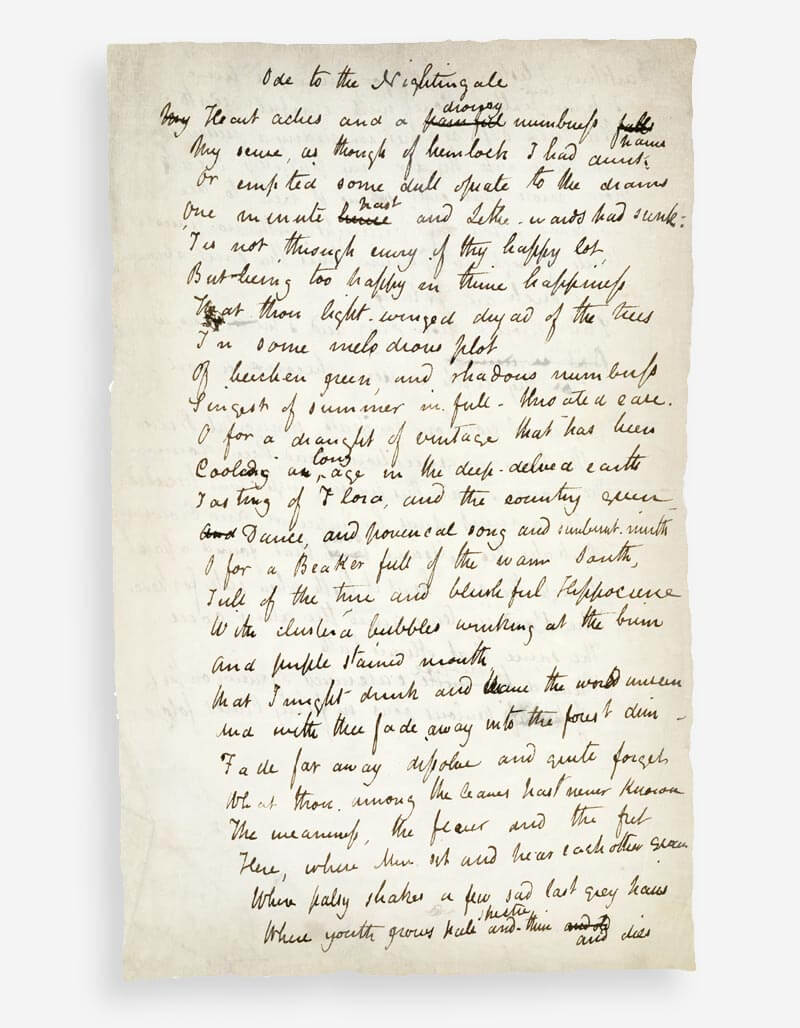
In 1819, again bereaved by the death of one of his brothers, the poet composed a series of six odes that would have an everlasting impact on readers: Ode on Indolence, Ode on Melancholy, Ode to Psyche, Ode on a Grecian Urn, Ode to a Nightingale, and To Autumn. Having previously committed himself to a career as a surgeon and apothecary, Keats had given up his job at the hospital to devote himself to literature and at the time, he was staying with his friend Charles Armitage Brown, a businessman and author, in Hampstead in North London.
“Poetic feelings on the song of the nightingale”
Seen from the windows of his friend’s sitting room, the plum tree in the garden was the inspiration for Keats’ Ode to a Nightingale, which was written hurriedly on two sheets of rough paper torn from a notebook. Charles Armitage Brown, who co-wrote a verse tragedy with Keats and was taking care of his health and material needs, later helped to establish his friend’s reputation after his death and recounted:
In the spring of 1819 a nightingale had built her nest near my house. Keats felt a tranquil and continual joy in her song; and one morning he took his chair from the breakfast-table to the grass-plot under a plum-tree, where he sat for two or three hours. When he came into the house, I perceived he had some scraps of paper in his hand, and these he was quietly thrusting behind the books. On inquiry, I found those scraps, four or five in number, contained his poetic feelings on the song of the nightingale.
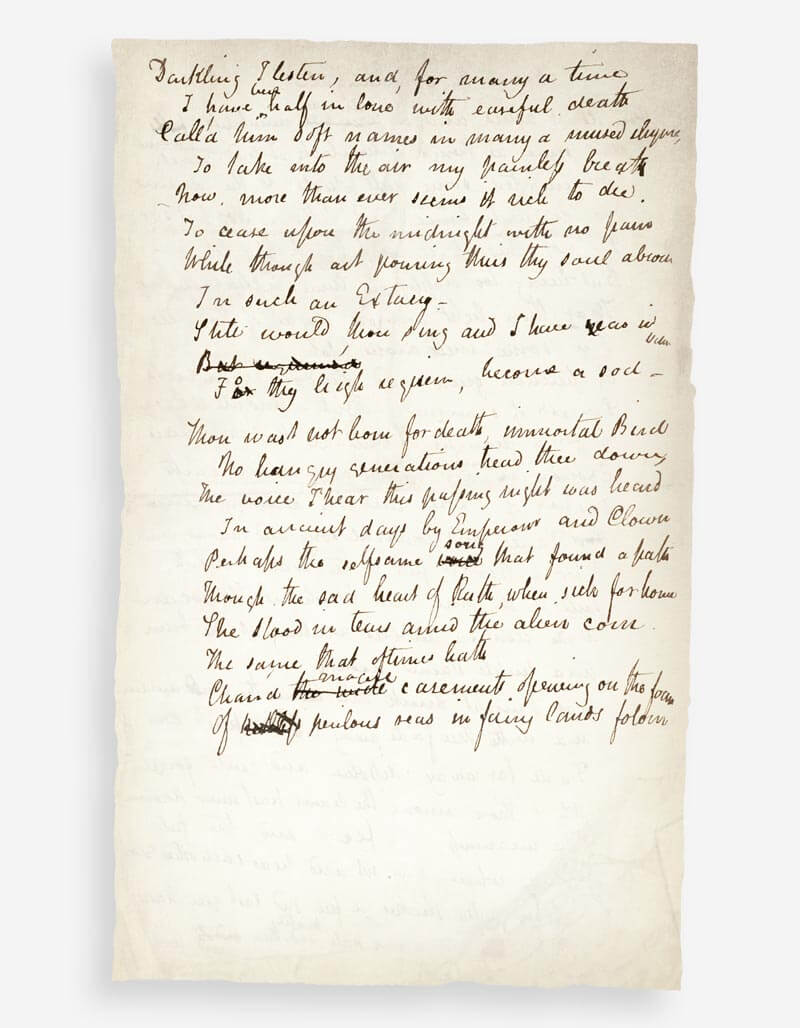
Ode to a Nightingale was first published in a review, then in the collection Lamia, Isabella, The Eve of St. Agnes, and Other Poems (July 1820).
Double-sided document presented in a double-glass framing (17 x 13").
Wooden frame, made in France. Each frame is hand-assembled in our workshops in Cambremer.
Mrs Dalloway: Thanks to a new reproduction of the only full draft of Mrs. Dalloway, handwritten in three notebooks and initially titled “The Hours,” we now know that the story she completed — about a day in the life of a London housewife planning a dinner party — was a far cry from the one she’d set out to write (...)
The Grapes of Wrath: The handwritten manuscript of John Steinbeck’s masterpiece The Grapes of Wrath, complete with the swearwords excised from the published novel and revealing the urgency with which the author wrote, is to be published for the first time. There are scarcely any crossings-out or rewrites in the manuscript, although the original shows how publisher Viking Press edited out Steinbeck’s dozen uses of the word “fuck”, in an attempt to make the novel less controversial. (...)
Jane Eyre: This is a book for passionate people who are willing to discover Jane Eyre and Charlotte Brontë's work in a new way. Brontë's prose is clear, with only occasional modifications. She sometimes strikes out words, proposes others, circles a sentence she doesn't like and replaces it with another carefully crafted option. (...)
The Jungle Book: Some 173 sheets bearing Kipling’s elegant handwriting, and about a dozen drawings in black ink, offer insights into his creative process. The drawings were not published because they are unfinished, essentially works in progress. (...)
The Lost World: SP Books has published a new edition of The Lost World, Conan Doyle’s 1912 landmark adventure story. It reproduces Conan Doyle’s original manuscript for the first time, and includes a foreword by Jon Lellenberg: "It was very exciting to see, page by page, the creation of Conan Doyle’s story. To see the mind of the man as he wrote it". Among Conan Doyle’s archive, Lellenberg made an extraordinary discovery – a stash of photographs of the writer and his friends dressed as characters from the novel, with Conan Doyle taking the part of its combustible hero, Professor Challenger. (...)
Frankenstein: There is understandably a burst of activity surrounding the book’s 200th anniversary. The original, 1818 edition has been reissued, as paperback by Penguin Classics. There’s a beautifully illustrated hardcover, “The New Annotated Frankenstein” (Liveright) and a spectacular limited edition luxury facsimile by SP Books of the original manuscript in Shelley's own handwriting based on her notebooks. (...)
The Great Gatsby: But what if you require a big sumptuous volume to place under the tree? You won’t find anything more breathtaking than SP Books ’s facsimile of F. Scott Fitzgerald’s handwritten manuscript of The Great Gatsby, showing the deletions, emendations and reworked passages that eventually produced an American masterpiece (...)
Oliver Twist: In the first ever facsimile edition of the manuscript SP Books celebrates this iconic tale, revealing largely unseen edits that shed new light on the narrative of the story and on Dickens’s personality. Heavy lines blocking out text are intermixed with painterly arabesque annotations, while some characters' names are changed, including Oliver’s aunt Rose who was originally called Emily. The manuscript also provides insight into how Dickens censored his text, evident in the repeated attempts to curb his tendency towards over-emphasis and the use of violent language, particularly in moderating Bill Sikes’s brutality to Nancy. (...)
Peter Pan: It is the manuscript of the latter, one of the jewels of the Berg Collection in the New York Public Library, which is reproduced here for the first time. Peter’s adventures in Neverland, described in Barrie’s small neat handwriting, are brought to life by the evocative color plates with which the artist Gwynedd Hudson decorated one of the last editions to be published in Barrie’s lifetime. (...)



